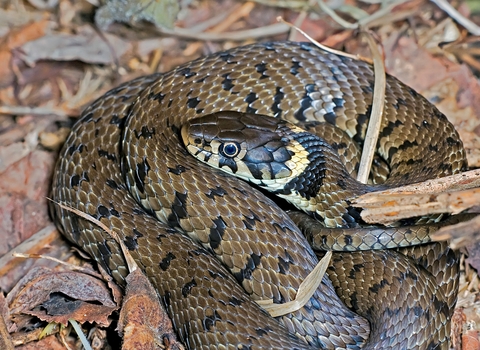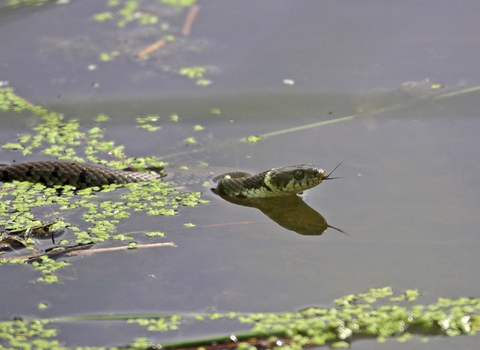
©David Chamberlain
Grass snake
The grass snake is our longest snake, but don't worry if you find one in the compost heap - it's harmless! Look out for this green and yellow beauty in grasslands and wetlands, too.
Scientific name
Natrix helveticaWhen to see
April to OctoberSpecies information
Category
Statistics
Length: 90-150cmWeight: 240g
Average lifespan: 15-25 years
Protected in the UK under the Wildlife and Countryside Act, 1981. Priority Species under the UK Post-2010 Biodiversity Framework.
About
Our largest snake, the grass snake, is particularly fond of wetland habitats, but can also be found in dry grasslands and in gardens, especially those with a pond nearby. During the summer, grass snake can be spotted basking in the sun near their favourite ponds or swimming in the water.They hunt amphibians, fish, small mammals and birds. Females lay 10 to 40 eggs in rotting vegetation, such as compost heaps, incubating them until they hatch in early Autumn. Like all reptiles, grass snake hibernate, usually from October to April.
Note
The British population of grass snake belongs to the distinct subspecies Natrix natrix helvetica, but new research published in August 2017 proposed that it should be elevated to full species status, with the name barred grass snake, Natrix helvetica.
How to identify
The grass snake is usually greenish in colour, with a yellow and black collar, pale belly, and dark markings down the sides. Females are bigger than males.Distribution
Widespread in England and Wales, but absent from Scotland, Northern Ireland, the Isles of Scilly and most of the Channel Islands (they are found on Jersey).Did you know?
When threatened by one of its many predators, the grass snake often 'plays dead', perhaps making itself less appealing to eat. Predators include badgers, red foxes, domestic cats, hedgehogs and a number of birds; when caught, grass snakes hiss and release a foul-smelling substance from their anal gland. Although they may also strike with the head, they do not bite and are harmless to humans.Watch
Grass snake (https://vimeo.com/646956073)
Russell Savory

